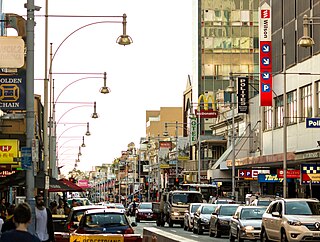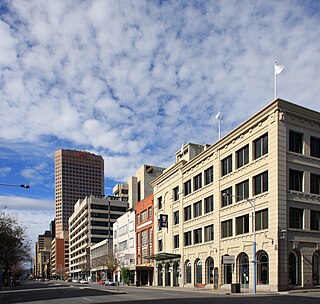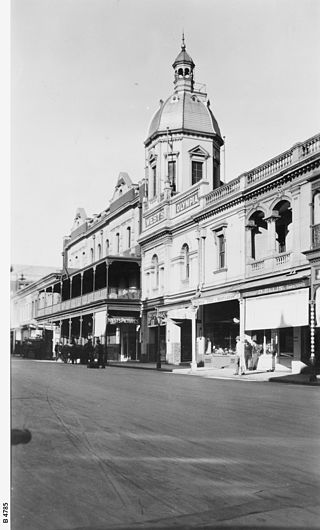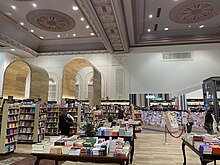
King William Street is the part of a major arterial road that traverses the CBD and centre of Adelaide, continuing as King William Road to the north of North Terrace and south of Greenhill Road; between South Terrace and Greenhill Road it is called Peacock Road. At approximately 40 metres (130 ft) wide, King William Street is the widest main street of all the Australian State capital cities. Named after King William IV in 1837, it is historically considered one of Adelaide's high streets, for its focal point of businesses, shops and other prominent establishments. The Glenelg tram line runs along the middle of the street through the city centre.

Rundle Street, often referred to as "Rundle Street East" as distinct from Rundle Mall, is a street in the East End of the city centre of Adelaide, the capital of South Australia. It runs from Pulteney Street to East Terrace, where it becomes Rundle Road through the East Park Lands. The street is close to Adelaide Botanic Gardens, Rundle Park, Rymill Park, Hindmarsh Square and North Terrace.

Queen Street is the main street of Brisbane, the capital of Queensland, Australia. It is named after Queen Victoria of the United Kingdom.

The Adelaide Central Market is a major fresh produce market in Adelaide, South Australia. As one of the oldest markets in Australia, Adelaide Central Market has a large range of fresh food, including fruit and vegetables, meat and poultry, seafood, cheeses, baked goods, small goods, and health foods, along with several cafés and eateries. Currently, approximately one million kilograms of fresh produce are delivered to the market and sold every month. It is a popular tourist attraction in the city, with more than 8.5 million visitors every year. It is also referred to simply as the Central Market. A $400 million redevelopment was approved in January 2021, which will include a mixed-use 35-storey building comprising offices, residential apartments and a hotel.

John Martin & Co. Ltd, colloquially known as John Martin's or simply Johnnies, was an Adelaide-based company which ran a popular chain of department stores in South Australia. It operated for more than 130 years, from 1866 until its closure in 1998. Johnnies, owned by the prominent Hayward family for the majority of its existence, became an Adelaide icon, responsible for the famous Adelaide Christmas Pageant.

The Myer Centre is a five-level shopping centre in the heart of the Adelaide city centre, South Australia.

Hindley Street is located in the north-west quarter of the centre of Adelaide, the capital of South Australia. It runs between King William Street and West Terrace. The street was named after Charles Hindley, a British parliamentarian and social reformist.

Grenfell Street is a major street in the north-east quarter of the Adelaide city centre, South Australia. The street runs west-east from King William Street to East Terrace. Its intersection with Pulteney Street is formed by Hindmarsh Square. On the west side of King William Street, it continues as Currie Street towards West Terrace.

Grote Street is a major street running east to west in the western half of Adelaide city centre, South Australia. It is on the northern border of Chinatown and the Adelaide Central Market, and is a lively centre for shopping and restaurants. The historic Her Majesty's Theatre is located here.

Currie Street is a main street in the Adelaide city centre, South Australia. It runs east–to–west from King William Street, through Light Square, to West Terrace on the western edge of the city centre.

Wakefield Street is a main thoroughfare intersecting the centre of the South Australian capital, Adelaide, from east to west at its midpoint. It crosses Victoria Square in the centre of the city, which has a grid street plan. It continues as Wakefield Road on its eastern side, through the eastern Adelaide Park Lands.

The former Plaza Theatre is located at 650–658 Hay Street, Perth, Western Australia. It was the first purpose-designed Art Deco cinema in Perth. The Plaza Theatre opened in 1937 and was built for Hoyts Theatres Ltd.

Adelaide Arcade is a heritage shopping arcade in the centre of Adelaide, South Australia. It is linked to, and closely associated with, Gay's Arcade.

The Adelaide Glaciarium, located at 89–91 Hindley Street in the city of Adelaide, South Australia, was the first indoor ice-skating facility built in Australia. It is also the location of the first "hockey on the ice" match in the country, which was an adaptation of roller polo for the ice using ice skates. Contemporary ice hockey was never played at this venue but this ice skating rink, the country's first, provided the "test bed" facility for its successor, the Melbourne Glaciarium, the birthplace of ice hockey in Australia.
Joseph Jackman was the founder of Jackman's Rooms which incorporated a restaurant "Jackman's Dining Room", meeting rooms, dance hall and banqueting room at 48–50 King William Street, Adelaide, and several other cafes in Adelaide, South Australia.
The Theatre Royal on Hindley Street, Adelaide was a significant venue in the history of the stage and cinema in South Australia. After a small predecessor of the same name on Franklin Street, the Theatre Royal on Hindley Street was built in 1868. It hosted both stage performances and movies, passing through several changes of ownership before it was eventually demolished to make way for a multi-storey car park in 1962.

Dan Clifford was a well-known cinema entrepreneur and philanthropist in South Australia. He was also a keen promoter of the cinema industry, and owned 20 cinemas across the state at the time of his death, including several in Art Deco style, such as the Piccadilly Theatre and the Goodwood Star.
Ozone Theatres Ltd, formerly Ozone Amusements, was a cinema chain based in Adelaide, South Australia, from 1911 until 1951, when it sold its theatres to Hoyts. It was founded by Hugh Waterman and was jointly run by him and seven sons, including Clyde Waterman and Sir Ewen McIntyre Waterman. S.A. Theatres and Ozone Theatres were subsidiary companies, and the chain was referred to as the Ozone circuit.
Wondergraph, Wondergraph Theatre and variations were names given first to a technology, and then to picture theatres run first by the Continental Wondergraph Company ; and then, in Adelaide, South Australia, by the Wondergraph Company (1910–1911), and then the Greater Wondergraph Company, established around 1911 and in existence until 1939.






































